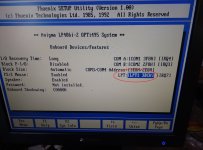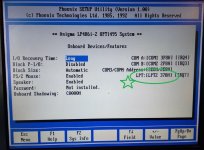modem7
10k Member
I have a cr2023 running to them but this system WILL NOT retain any of its settings. I have no idea why. The date and time are correct in the photo only because I just updated it.
And the PSRSTB# pin too (just to be sure) ?I put the jumper back in where I originally had it and I can get 3.1V at both VCC pins on the 82c206 powered off. Powered on I get 4.91V from both VCC pins.
And measuring 3.1V with a CR2032 in place, presumably you have the J8 jumper in the 3-4.5V setting.
Reading the OPTi 82C206 datasheet, I do not see anything like "3-6V operation" for the Vcc pin.
The best that I can find is in section 5.1, that indicating a maximum rating of +6.7V for the Vcc pin.
Could it be that 3.1V is too low for operation of the OPTi 82C206 ?
Do you have the means to connect up a larger voltage battery ?


